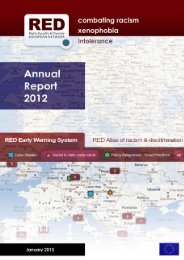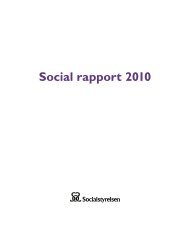Entry Testing and the Overrepresentation of Romani ... - UR Research
Entry Testing and the Overrepresentation of Romani ... - UR Research
Entry Testing and the Overrepresentation of Romani ... - UR Research
- No tags were found...
You also want an ePaper? Increase the reach of your titles
YUMPU automatically turns print PDFs into web optimized ePapers that Google loves.
R30PITFALLS AND BIASWhile <strong>the</strong> test claims to be relatively free <strong>of</strong> cultural bias, non-dominant cultural communities, such as illiterateCongolese mine workers, who traditionally do not do well on <strong>the</strong> Progressive Matrices improve <strong>the</strong>ir performancewith repeated administrations, that is, as <strong>the</strong>ir familiarity with <strong>the</strong> testing conditions/procedures grow(Ombrédane, Robaye, <strong>and</strong> Plumail 1956 as cited in Brouwers et al. 2009, 331). Nonverbal tests in fact do requirelanguage – <strong>the</strong> instructions for <strong>the</strong> test, <strong>the</strong> conceptual skills that can be learned only through pr<strong>of</strong>iciency in alanguage – <strong>and</strong> language is related to culture (Oller 1997, 488; Gunderson <strong>and</strong> Siegel 2001, 51).Two studies examined how testing conditions <strong>and</strong> training impact children’s scores on <strong>the</strong> CPM. Klauer <strong>and</strong> Willmes(2002) conducted a study in which one group <strong>of</strong> first-grade children were specifically taught inductive reasoningstrategies while <strong>the</strong> o<strong>the</strong>r group engaged in regular classroom activities. The group <strong>of</strong> children who were taughtinductive reasoning strategies performed better on <strong>the</strong> CPM than those children who did not have specific strategyinstruction. Désert, Préaux, <strong>and</strong> Jund (2009, 210) presented instructions for <strong>the</strong> assessment in two differentways: (1) as required by <strong>the</strong> manual: “We are going to do a series <strong>of</strong> exercises toge<strong>the</strong>r in order to evaluate <strong>the</strong>domains you succeed in <strong>and</strong> those where you fail, to know your strengths <strong>and</strong> weaknesses. Do you best so we canknow your strengths <strong>and</strong> your weaknesses,” <strong>and</strong> (2) in a non-evaluative way: “We are going to do a series <strong>of</strong> gamestoge<strong>the</strong>r because we created new games, <strong>and</strong> we want to know if <strong>the</strong>y are well adapted to children <strong>of</strong> yourage. Do you best so that we can know if <strong>the</strong> games are suitable for children <strong>of</strong> your age.” These evaluative <strong>and</strong> nonevaluativeinstructions were given to French pupils from low <strong>and</strong> high socio-economic strata in test administrationtrials. The non-evaluative “game” instructions did not affect <strong>the</strong> performance <strong>of</strong> pupils with high socio-economicstatus (SES), but this test condition brought improved results <strong>of</strong> pupils from low-SES households, who mighthave been more keenly aware <strong>of</strong> lowered expectations associated with <strong>the</strong>ir families <strong>and</strong> backgrounds, thusimpacting <strong>the</strong>ir performance when told that a measure was a test <strong>of</strong> <strong>the</strong>ir own abilities, as opposed to testing<strong>the</strong> measure’s appropriateness for children <strong>the</strong>ir age. Thus, method matters in assessing intelligence, <strong>and</strong> noinstrument that measures a construct can be completely free from cultural bias.SUMMARYAn assessment <strong>of</strong> intelligence is valid only ins<strong>of</strong>ar as it has been normed with all representative populations<strong>of</strong> a country or region <strong>and</strong> appropriately measures what it is supposed to measure. An assessment can be used todetermine a child’s areas <strong>of</strong> strengths <strong>and</strong> weaknesses for instructional planning purposes. However, it is <strong>the</strong>inappropriate <strong>and</strong> biased ways in which <strong>the</strong>se instruments are used that lead to segregation <strong>and</strong> denial <strong>of</strong> equality<strong>of</strong> educational opportunity for <strong>Romani</strong> children. Factors leading to misinterpretation <strong>of</strong> test results include <strong>the</strong>use <strong>of</strong> translations <strong>of</strong> tests, under-representation <strong>of</strong> certain ethnic or language groups when <strong>the</strong> test is st<strong>and</strong>ardized,<strong>and</strong> <strong>the</strong> failure to create a comfortable <strong>and</strong> engaging testing environment. Misdiagnosis can occur as a result<strong>of</strong> imprecise reporting <strong>of</strong> results, not following test administration protocol, or administering <strong>the</strong> test in culturallyor linguistically inappropriate ways. Finally, practitioner malpractice may occur as a result <strong>of</strong> blatant bias or




